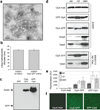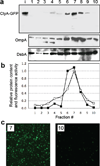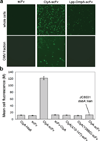Engineered bacterial outer membrane vesicles with enhanced functionality
- PMID: 18511069
- PMCID: PMC4617544
- DOI: 10.1016/j.jmb.2008.03.076
Engineered bacterial outer membrane vesicles with enhanced functionality
Abstract
We have engineered bacterial outer membrane vesicles (OMVs) with dramatically enhanced functionality by fusing several heterologous proteins to the vesicle-associated toxin ClyA of Escherichia coli. Similar to native unfused ClyA, chimeric ClyA fusion proteins were found localized in bacterial OMVs and retained activity of the fusion partners, demonstrating for the first time that ClyA can be used to co-localize fully functional heterologous proteins directly in bacterial OMVs. For instance, fusions of ClyA to the enzymes beta-lactamase and organophosphorus hydrolase resulted in synthetic OMVs that were capable of hydrolyzing beta-lactam antibiotics and paraoxon, respectively. Similarly, expression of an anti-digoxin single-chain Fv antibody fragment fused to the C terminus of ClyA resulted in designer "immuno-MVs" that could bind tightly and specifically to the antibody's cognate antigen. Finally, OMVs displaying green fluorescent protein fused to the C terminus of ClyA were highly fluorescent and, as a result of this new functionality, could be easily tracked during vesicle interaction with human epithelial cells. We expect that the relative plasticity exhibited by ClyA as a fusion partner should prove useful for: (i) further mechanistic studies to identify the vesiculation machinery that regulates OMV secretion and to map the intracellular routing of ClyA-containing OMVs during invasion of host cells; and (ii) biotechnology applications such as surface display of proteins and delivery of biologics.
Figures







Similar articles
-
Delivery of foreign antigens by engineered outer membrane vesicle vaccines.Proc Natl Acad Sci U S A. 2010 Feb 16;107(7):3099-104. doi: 10.1073/pnas.0805532107. Epub 2010 Jan 27. Proc Natl Acad Sci U S A. 2010. PMID: 20133740 Free PMC article.
-
Vesicle-mediated export and assembly of pore-forming oligomers of the enterobacterial ClyA cytotoxin.Cell. 2003 Oct 3;115(1):25-35. doi: 10.1016/s0092-8674(03)00754-2. Cell. 2003. PMID: 14532000
-
Display of Recombinant Proteins on Bacterial Outer Membrane Vesicles by Using Protein Ligation.Appl Environ Microbiol. 2018 Apr 2;84(8):e02567-17. doi: 10.1128/AEM.02567-17. Print 2018 Apr 15. Appl Environ Microbiol. 2018. PMID: 29439988 Free PMC article.
-
Cytolysin A (ClyA): A Bacterial Virulence Factor with Potential Applications in Nanopore Technology, Vaccine Development, and Tumor Therapy.Toxins (Basel). 2022 Jan 21;14(2):78. doi: 10.3390/toxins14020078. Toxins (Basel). 2022. PMID: 35202106 Free PMC article. Review.
-
Heterologous protein secretion and the versatile Escherichia coli haemolysin translocator.Trends Biotechnol. 1994 Nov;12(11):450-5. doi: 10.1016/0167-7799(94)90020-5. Trends Biotechnol. 1994. PMID: 7765544 Review.
Cited by
-
On-Demand Vaccine Production via Dock-and-Display of Biotinylated Antigens on Bacterial Extracellular Vesicles.Methods Mol Biol. 2024;2843:195-216. doi: 10.1007/978-1-0716-4055-5_13. Methods Mol Biol. 2024. PMID: 39141302
-
Neisseria meningitidis Factor H Binding Protein Surface Exposure on Salmonella Typhimurium GMMA Is Critical to Induce an Effective Immune Response against Both Diseases.Pathogens. 2021 Jun 9;10(6):726. doi: 10.3390/pathogens10060726. Pathogens. 2021. PMID: 34207575 Free PMC article.
-
Functionalization of OMVs for Biocatalytic Applications.Membranes (Basel). 2023 Apr 24;13(5):459. doi: 10.3390/membranes13050459. Membranes (Basel). 2023. PMID: 37233521 Free PMC article. Review.
-
Cell membrane-derived nanomaterials for biomedical applications.Biomaterials. 2017 Jun;128:69-83. doi: 10.1016/j.biomaterials.2017.02.041. Epub 2017 Mar 1. Biomaterials. 2017. PMID: 28292726 Free PMC article. Review.
-
Opportunities and challenges of bacterial extracellular vesicles in regenerative medicine.J Nanobiotechnology. 2025 Jan 3;23(1):4. doi: 10.1186/s12951-024-02935-1. J Nanobiotechnology. 2025. PMID: 39754127 Free PMC article. Review.
References
-
- Galan JE, Collmer A. Type III secretion machines: bacterial devices for protein delivery into host cells. Science. 1999;284:1322–1328. - PubMed
-
- Gentschev I, Dietrich G, Goebel W. The E. coli alpha-hemolysin secretion system and its use in vaccine development. Trends Microbiol. 2002;10:39–45. - PubMed
-
- Henderson IR, Cappello R, Nataro JP. Autotransporter proteins, evolution and redefining protein secretion. Trends Microbiol. 2000;8:529–532. - PubMed
-
- Russel M. Macromolecular assembly and secretion across the bacterial cell envelope: type II protein secretion systems. J Mol Biol. 1998;279:485–499. - PubMed
Publication types
MeSH terms
Substances
Grants and funding
LinkOut - more resources
Full Text Sources
Other Literature Sources

